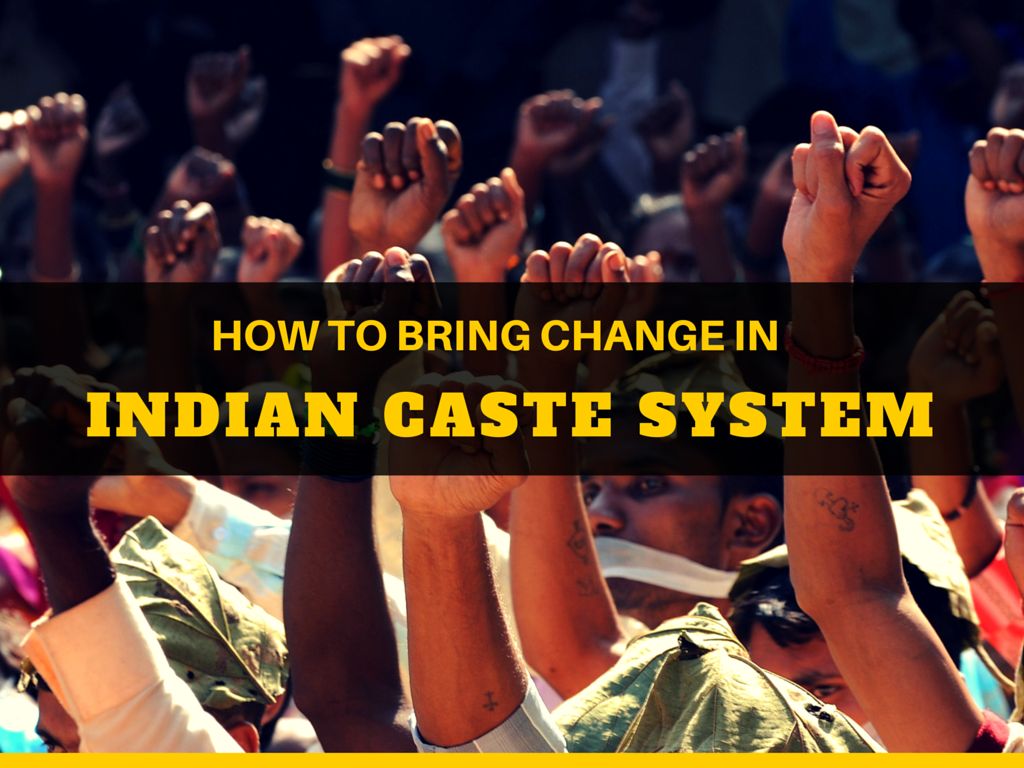How to Bring Change in Indian Caste System?

Caste system is an ancient factor of Hindu religion and culture, which historically separated communities into thousands of endogamous inherent groups of jatis and the jatis were further divided into four varnas named as Brahmins, Kshatriyas, Vaishyas and Sudras. But, it is believed now that the caste system is now changing significantly from last two decades. Changes in caste system are categorized into three types, that are structural changes, functional changes and attitudinal changes. However, after achieving independence, India is being administered under the policy of caste-based reservation of jobs with formalised lists of Scheduled Caste and Scheduled Tribe.
Discrimination against lower castes is purely illegal in our country under Article 15 of Indian constitution. Since 1950, our nation has enforced many laws and social acts to alter and improve caste system in India. Hence caste system is enduring rapid transformations under the influence of certain powerful factors in modern India. There are some factors that only can bring significant change in Indian Caste System.
1. Contemporary Education
Contemporary and liberal education introduced by British government in India has played a very vital role in eroding the necessity of caste system in social life of India. Contemporary or modern education is framed by democratic values such as liberty, equality and fraternity. Modern education is based on scientific values such as observation and reason. Henceforth, it’s quite obvious that the evolution of modern education has created a strong complication in people’s belief in caste and karma.
Modern education which is usually bestowed in co-educational institutions, encourages and promotes inter-caste marriages and inter-caste mixing, which is powerful force to eliminate caste and untouchability from India.
2. Westernization
‘Westernization’ was introduced in the Indian society during the British rule. By promoting education, democracy, rationalism, humanism and a crucial outlook towards various social issues and affairs, westernization has created a significant change going a long way in eroding the traces of the caste system. It has given severe attack to ancient practices like child marriage, commensality, purity and pollution, untouchability etc. However, the effect of westernization which is distinctly visible in the form of inter-caste marriages, intercommunity marriages, inter-religious marriages, occupational changes etc in our Indian society.
3. Secularism
The role of secularism or secularization is no doubt weakening the caste system is deep from its root. By implying secular ideologies, concepts and formal legal doctrines and hence introducing scientific views, rationality, and modern culture, secularization has overblown certain characteristics and features of the caste system especially the concept of communalism, purity and pollution, and priority of caste in occupation etc.
4. Emerging Industrialization
The emergence of Industrialization has affected caste system and its structure remarkably to a significant extent. Industrial development has given new sources of livelihood to people and made occupational potency possible. Factories, mills, offices, malls are keen with activity. And the most important thing between all these is the people who belong to various castes consider it primitive to go into the question of one’s caste. For example, in factory a Brahmin and a Sudra would be working side by side that even in the similar level.
5. Urbanization
Industrialization has ultimately given birth to the process of urbanization. New townships, cities have emerged. The rural people are migrating to these towns in order to grab better employment opportunities. And with these evolving big hotels, restaurants, theatres, clubs and educational institutions, it totally not possible to keep eye on communal inhibitions and taboos against food-sharing or touchability.
6. Socialistic Views
Caste system is grounded on the concept of high birth and low birth, and the socialists have to assert that the differentiation between human beings have been generated by society only; that’s why it can be removed by these society only.
7. Social Movements
New social movements have also undermined the caste system. The Brahmo Samaj movement founded by Raja Ram Mohan Roy rejected the obstacles of caste divisions and stood for universality and brotherhood of people. The Prarthana Sabha movement supervised by Justice Ranade brought in some social rectifies like inter-caste marriages. The Arya Samaj movement founded by Swami Dayananda Saraswati and Ramakrishna Mission movement protested against the hereditary caste system grounded on birth and stood for its abrogation.
8. Reformed Legal System
The reformed legal system, promoted by the British Government, has given a severe attack to the caste system in India. The old age discrimination against the lower castes has been removed. Moreover, the establishment of law courts has made the traditional castes Panchayats to lose their power and effectiveness for punishing the deviants. Not only this, numerous Acts like the Untouchability Offences Act of 1955 and the Hindu Marriage Act of 1955 have relinquished the evil effects and impacts of the caste system.
9. Emergence of new Social classes
Industrialization has sprouted the emergence of new social classes. These new social classes are superseding the traditional castes and the beliefs. Merchants’ Associations, Trade Unions and Political Parties are ousting the old caste concepts and views. A prominent hike in class consciousness is leading to a fall in caste consciousness.
Now, these factors, education, westernization, secularization, social classes, social movements, urbanization have created a vast change and reform in our Indian society and culture. But, are these factors enough for the abolition of caste system from our nation? I am saying this, because, there are still some regions such as Rajasthan, Haryana, Bihar, UP, Odisha are still facing many problems regarding caste system. And the most crucial issues related to caste system are inter-caste marriage and child marriage, which is still breathing in our society and not yet completely rooted out. All these above effective factors have overblown the caste system with their best efforts and have brought structural and functional changes in Indian society, and the rest needs attitudinal change which are yet to be relinquished depends on us, we people. So, change your mind to change your society for a new India.
MORE FROM MOSTINSIDE
Recommended For You
A Guide to Efficient Waste Management in Your City
Priyadarshini Muduli
A full time passionate writer with imperishable determination to bring healthy, smart and pragmatic changes individually and socially. Concentrate especially on lifestyle, life and personal improvement, relationships, mental health and behavior, viral issues and literature based subjects.




